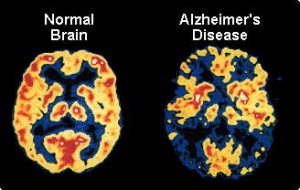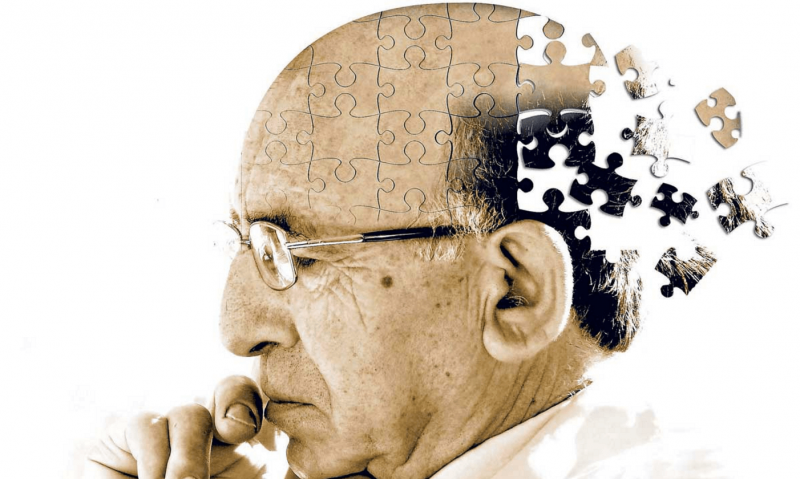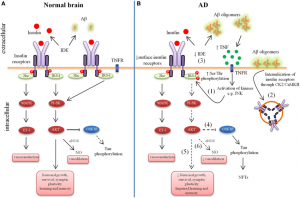We all know someone who has been affected by Alzheimer’s disease: maybe a neighbor, a family member, or even a teacher/mentor. Alzheimer’s is a terrible disease that slowly takes away a person’s ability to function by increasingly disintegrating the neurons and their connectivity. But what IS happening when a person has Alzheimer’s disease? Why is this illness almost inevitable in the United States? And how can we stop it?
It is believed that Alzheimer’s occurs in people when there is plaque build-up from neural tangles in the brain. In recent studies, scientists have found a correlation between those with type-2 diabetes and Alzheimer’s. People with type-2 diabetes (T2D) have a resistance to insulin, the hormone that decreases glycogen levels in the body. Studies have found that the insulin signaling pathway is also essential to forming memories and preventing Alzheimer’s disease (AD). Here are a few theories on why:

TNF-alpha (a cell signaling protein involved in systematic inflammation and is a cytokine that reacts to danger) mediated inflammation:
- ABOs cause inflammation
- Cause insulin resistance
- Brain inflammation mediated by microglia
- Impairs synaptic function
- Intersects with ER stress
Unchecked PTP1B activity:
- Upregulates neuroinflammation-PTP1B positive regulator of microglia-mediated neuroinflammation
- Down regulates brain insulin, leptin ( found in hippocampus and prevents plaque build-up) and BDNF (growth of neurons) signaling
- Impact synapse dynamics and stability and cognition
- ER stress is associated with peripheral insulin resistance in inflammatory conditions
Deregulated mTOR signaling:
- Increase uncoupling of IR and IRS (insulin receptors)
- Retro inhibits IRS-1 (insulin receptor substrate)
- Impairs synaptic plasticity and cognition
- Deregulates autophagy
- Causes cell cycle re-entry
Aberrant ganglioside metabolism:
- Increase of GM3 & GM1 (gangliosides) causes the uncoupling of IR & IRS-1 and accumulation of ABOs which can turn into tangles which then turn into plaques
- Impairs AB aggregation
- Serves as receptors for AB in the membrane
- Required for ASB synaptotoxicity
What can we do to fix it?
Because we are seeing a correlation between T2D and AD, why not use T2D medications to treat AD? Insulin and Metformin are two drugs that scientists are experimenting with to see if they decrease the risk of developing AD in the future.
- Insulin:
- It is recognized that in patients with AD, the amount of insulin signaling in the insulin signaling pathway is very low. Using insulin injections, typically used for diabetes patients, studies have shown improvements in memory. For many of the studies, the insulin is more effective for older patients compared to younger ones. The insulin can be delivered two different ways: intravenously and intranasally.
- Insulin infusion “is achieved using the hyperinsulinemic-euglycemic clamp method, where circulating insulin levels are raised by a controlled infusion of insulin while glucose levels are monitored and maintained constant through glucose infusion” (Morris, 2012).
- The intranasal is a new process that is still being tested of its effectiveness. Instead of using the bloodstream to deliver the insulin, administration of the drug is done through the olfactory and trigeminal pathways. This new way of delivery is thought to be better as it is less invasive and less painful. By avoiding the bloodstream, intranasal delivery of insulin does not risk causing hypoglycemia in the patient.
- It is recognized that in patients with AD, the amount of insulin signaling in the insulin signaling pathway is very low. Using insulin injections, typically used for diabetes patients, studies have shown improvements in memory. For many of the studies, the insulin is more effective for older patients compared to younger ones. The insulin can be delivered two different ways: intravenously and intranasally.
Caption: “Insulin signaling deficits in AD brain. Several studies have compared insulin signaling in nondemented and AD subjects in postmortem brain tissue. Deficits in insulin signaling associated with AD include decreased expression of insulin receptor, insulin receptor substrate (IRS), phosphoinositide 3-kinase (PI3K), and AKT and decreased AKT activity (phosphorylation). Preclinical studies have also shown that amyloid beta (Aβ) can compete with insulin for insulin receptor binding and impair interaction of AKT and phosphoinositide-dependent kinase (PDK1). Because glycogen synthase kinase-3 (GSK-3) lies downstream of AKT, it is possible that these effects could influence tau phosphorylation” (Morris, 2012)31
- Metformin:
- After seeing the correlation between those with T2D and AD, the thought was to use other medications that alleviate the effects of diabetes to potentially help with Alzheimer’s. Metformin is a common drug used in cases of mild diabetes. It works by activating the AMP-activated protein kinase with then proceeds to inactivate the mTOR/p70S6K-mediated negative feedback loop to insulin receptor substrate-1 (IRS-1) , thus enhancing insulin signaling. AMPK also regulates tau phosphorylation, Aβ production, and autophagy, all of which are critical processes in AD. Metformin has also been shown to cross the blood-brain barrier. There has been some controversy over whether or not metformin is an effective way to treat AD. A study in Taiwan took people with T2D and treated them with various types of diabetes medications. Compared to all of them, metformin did the best in reducing the hazard ratio, decreasing from 1 to 0.76 (Koenig, 2017)32. However, metformin can also decrease the amount of vitamin B12 in the body, which is a risk factor to developing AD. In a study where vitamin B12 was regulated, metformin made no difference in preventing AD33.
I sincerely hope that a cure for Alzheimer’s disease is discovered very soon. I was recently on the phone with my best friend, my great-grandmother, who is 92 years old. She has been doing great for her age, still living alone in a duplex apartment. I notice that she often tells the same stories to me every time I visit, but I have never been too worried about that. The last time I talked to her on the phone, she completely forgot what month it was. She thought it was still summer and that school had not started yet. Once I corrected her and she was no longer confused, she told me to not tell anyone that she made that mistake. It scares me because I know that AD is a fast-moving disease and it won’t be long until Grandma forgets more important things. I hope a cure can be found so that no one has to go through the pain of taking care of a loved one with Alzheimer’s Disease.
Citation:
https://www.ncbi.nlm.nih.gov/pmc/articles/PMC5476214/
https://www.alzdiscovery.org/cognitive-vitality/ratings/metformin
https://moodle.cord.edu/pluginfile.php/723477/mod_resource/content/0/2018%20AD%20and%20insulin%20signaling.pdf

